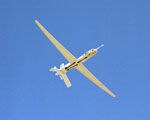
ACES News ACES story at the Earth Observatory:
Lightning Spies
 by Michon Scott
by Michon Scott
Excerpt: With a primary goal of validating LIS data, the ACES project examined thunderstorms in the Florida Everglades region over a four-week period in August 2002. Key to the study was the ALTUS II, an uninhabited aerial vehicle capable of flying at high altitudes for long durations. Especially useful to ACES was ALTUS II’s ability to fly at relatively slow speeds, between 70 and 100 knots, or approximately 70 miles (113 kilometers) per hour....
Read the entire article: http://earthobservatory.nasa.gov/Study/aces/
ACES was the cover story
of the January 2003 issue of
Aerospace America:
SPYING ON STORMS
Experimental UAVs that fly slowly around thunderstorms allow better studies of lightning and other weather hazards.
250 years after Ben Franklin's key and kite experiment:
NASA and university scientists seek key to lightning
In 1752, Ben Franklin used a key on a kite string to study lightning. In 2002, NASA and university scientists devoted the month of August studying the same phenomena - this time using a remotely piloted aircraft soaring to heights of more than 50,000 feet.
Both experiments were "firsts," offering new insight into dangerous weather disturbances and what fuels them. Read the entire news release...
NASA lightning study achieves flight-duration milestone, monitoring four storms in single mission
 A NASA team flying an uninhabited aerial vehicle to study thunderstorms achieved a milestone Wednesday, Aug. 21, completing the study's longest-duration research flight --- six hours and 32 minutes - and monitoring four thunderstorms in succession. Read the entire news release...
A NASA team flying an uninhabited aerial vehicle to study thunderstorms achieved a milestone Wednesday, Aug. 21, completing the study's longest-duration research flight --- six hours and 32 minutes - and monitoring four thunderstorms in succession. Read the entire news release...
NASA Lightning Study Completes First Flight of Uninhabited Aerial Vehicle
 A NASA team studying the causes of electrical storms and their effects on our home planet launched their first research flight Sunday, Aug. 4, using an uninhabited aerial vehicle to overfly the Florida Everglades. Based at the Naval Air Facility Key West, Florida, researchers with the Altus Cumulus Electrification Study (ACES) used an uninhabited aerial vehicle, or UAV, to make four passes over a storm in the western portion of the Everglades. Read the entire news release...
A NASA team studying the causes of electrical storms and their effects on our home planet launched their first research flight Sunday, Aug. 4, using an uninhabited aerial vehicle to overfly the Florida Everglades. Based at the Naval Air Facility Key West, Florida, researchers with the Altus Cumulus Electrification Study (ACES) used an uninhabited aerial vehicle, or UAV, to make four passes over a storm in the western portion of the Everglades. Read the entire news release...
 To better understand both the causes of an electrical storm's fury and its effects on our home planet, NASA and university research scientists will use a tool no atmospheric scientist has ever used to study lightning — an uninhabited aerial vehicle.
To better understand both the causes of an electrical storm's fury and its effects on our home planet, NASA and university research scientists will use a tool no atmospheric scientist has ever used to study lightning — an uninhabited aerial vehicle.
The research is part of the Altus Cumulus Electrification Study (ACES), a collaboration among NASA's Marshall Space Flight Center, Huntsville, Ala.; the University of Alabama at Huntsville; NASA's Goddard Space Flight Center, Greenbelt, Md.; Penn State University, University Park; and General Atomics Aeronautical Systems, Inc., San Diego. Read the entire news release...
 Movies of the Altus in action and interviews with the ACES investigators are now available.
Movies of the Altus in action and interviews with the ACES investigators are now available.








